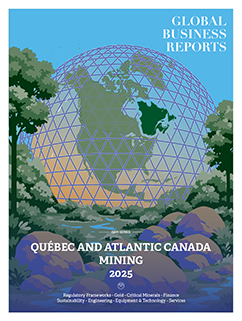
"By targeting committed investors and maintaining strong regulatory and Indigenous relations, the province hopes to accelerate responsible mineral development and establish itself as a serious, results-oriented jurisdiction."
RELATED PUBLICATION
John Herron
MINISTER OF NATURAL RESOURCES, GOVERNMENT OF NEW BRUNSWICK
Where does mining fit in New Brunswick’s economic strategy?
New Brunswick is recalibrating its economic strategy amid a shifting geopolitical landscape and a more complex trading relationship with the US. The province is embracing a “trust but diversify” approach to trade while seeking to unlock dormant sectors such as mining. Once contributing 7% of provincial GDP, mining now represents less than half of that. However, global demand for stable sources of critical minerals positions New Brunswick as a potential safe haven. Its value proposition includes two deepwater ports, extensive existing road access to mineral resources, and one of Canada's fastest-growing container ports.
In addition, 40,000 km of forestry roads offer logistical advantages over other jurisdictions. The province also benefits from a collaborative relationship with Indigenous communities, with equity participation seen as the highest form of consultation. Combined with world class mineral deposits and a willingness to restart or initiate new projects, these factors suggest New Brunswick is poised for renewed mining-driven growth.
Could you outline the province’s upcoming new mineral strategy?
As Minister, I have been tasked with delivering a comprehensive mineral strategy. The framework will outline best practices in Indigenous relations, capital attraction and sector participation. Its foundation will rest on three pillars: environmental responsibility, regulatory predictability, and authentic First Nation partnerships. Project proponents will be rigorously tested on environmental grounds, but in exchange, the permitting process must be timely and reliable to attract investment. I have proactively engaged all 16 First Nations leaders, seeking early collaboration. Initial responses have been open.
The strategy will also align developers with viable mineral opportunities in copper, zinc, antimony, indium, tungsten, and manganese, favoring companies with sufficient capital to advance projects. A “white glove” approach will support participants, while regulators are encouraged to distinguish between restarts and greenfield sites. In short, New Brunswick aims to accelerate development without compromising environmental or social standards – constructively impatient, but committed to getting it right.
When will the strategy be launched?
We aim to unveil the new mineral strategy framework at our annual Exploration, Mining and Petroleum conference in October, viewing this as a key moment to deepen ties with the mining sector. I see a need to elevate engagement, particularly with mid-tier companies that possess the capital and credibility to advance projects independently or attract major partners. While exploration remains vital, the province is shifting toward more proactive, relationship-driven outreach. The focus is on securing participants willing and able to develop assets – not merely hold claims. By targeting committed investors and maintaining strong regulatory and Indigenous relations, the province hopes to accelerate responsible mineral development and establish itself as a serious, results-oriented jurisdiction.
How would you compare New Brunswick’s future mining potential to the sector’s previous activity?
New Brunswick’s untapped mining potential exceeds that of the province’s previous peak, when mining contributed 7% of GDP two decades ago. Dormant assets now offer a broader and more diverse resource base, setting that historical benchmark as a realistic starting point. The province sees mining not only as a driver of extraction but also of value-added processing, supported by strong logistics and port infrastructure, particularly around the port of Belledune. Several host communities are open to development, enhancing feasibility. This could mark a transformative period for New Brunswick – laying the foundation for a durable, prosperous mining industry with long-term benefits for the province’s economy.
What factors would you say make New Brunswick a great mining jurisdiction?
The province hosts promising resources in indium, antimony, molybdenum, tungsten, gold, copper, zinc, and potash. Its extensive road network and port access strengthen its logistical appeal. Crucially, New Brunswick intends to position its respectful, proactive relationships with First Nations as a core part of its investment case – offering companies a faster, more collaborative path to development.
The forthcoming strategy will balance a rigorous but not burdensome environmental regime with the predictability and speed capital markets require. As a relatively small jurisdiction, New Brunswick aims to move faster than others, offering tailored, high-level support to sector participants. The goal is audacious: to create an investor-ready framework that secures social license while unlocking the province’s full mineral potential.











